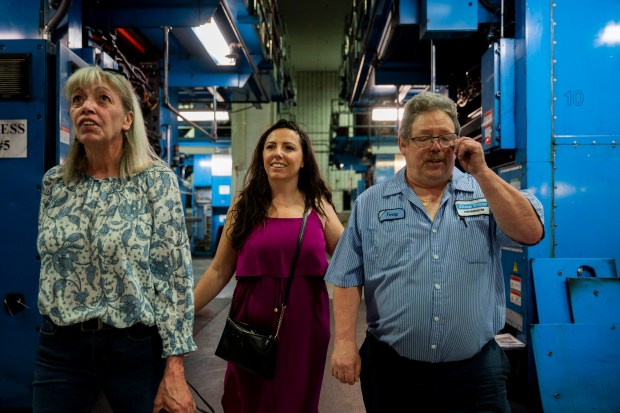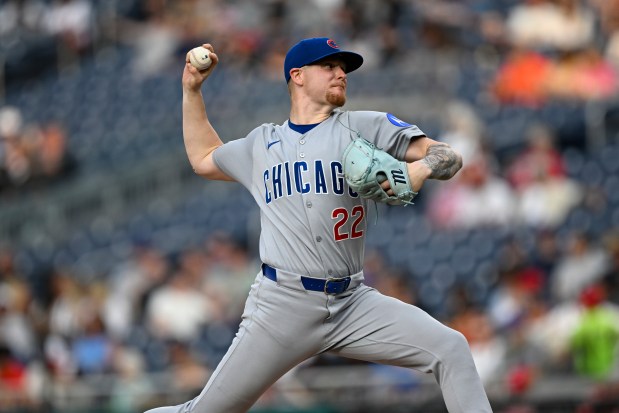When the heavily-used presses at the Freedom Center geared up over the weekend to print the Sunday Chicago Tribune, it gave new meaning to the term final edition. After 43 years of spewing out countless millions of newspapers, the production run was the last for the Chicago Tribune at the massive plant along the Chicago River.
The largest newspaper printing plant in North America is coming down. Chicago’s first casino will go up in its place.
Downsizing to a suburban facility, the Tribune will print on. But the imminent demise of the Freedom Center marks the end of an era, as newspaper circulation declines turn once-bustling printing plants into the buggy whip factories of the digital age.
Freedom Center is being demolished to make way for a planned Bally’s Chicago Casino complex. Tribune Publishing is moving its printing operations to the northwest suburban Daily Herald plant, a smaller but newer facility it purchased in May 2023 for an undisclosed price.
The Monday edition of the Chicago Tribune will be the first in the newspaper’s storied 177-year history not printed in Chicago, bearing instead a made-in-Schaumburg imprimatur.
“It’s kind of bittersweet,” said Scott LaBadie, 55, of South Holland, a 32-year Freedom Center veteran press operator working the night shift Saturday. “I have the ironic duty of doing the last edition here at the Freedom Center, and tomorrow, I have the pleasure of doing the first edition in Schaumburg.”
LaBadie was one of about a dozen press operators on duty for the emotional final run of the Chicago Tribune at the Freedom Center. Many were wearing old school pressman’s hats made out of newspapers and custom T-shirts featuring the grim reaper marking the end of the printing plant itself.
They were scheduled to print 160,000 copies of the Sunday Chicago Tribune and 49,000 copies of the Sunday Chicago-Sun-Times, both of which would be moving over to the Schaumburg plant for the Monday editions.
In addition, the crew was printing 25,000 copies of the New York Times, which is scheduled to run for two more weeks at the Freedom Center before shifting to Schaumburg.
If all went well, they would be wrapping it up at midnight, but multiple mechanical problems threatened to make it a long night. After starting the Tribune at 9 p.m., one of two presses dedicated to the run flashed an oil warning light and had to be shut down. The press handling the Sun-Times, which was scheduled to begin its run at 11 p.m., developed electrical problems and was in danger of being delayed. The New York Times press also experienced some glitches.
“We run until it’s done,” LaBadie said.
Eventually, all the balky presses got going, and the Chicago Tribune completed its final Freedom Center run at 12:48 a.m. on Sunday.
The dingy swan song was a long way from the glory days at Freedom Center, when all the presses would be humming, tended by dozens of operators, printing more than a million copies of the Sunday Chicago Tribune alone.
“For more than four decades, the Freedom Center has played a pivotal role for the Chicago Tribune,” said Par Ridder, the newspaper’s general manager. “However, it was built in and for a different time. Now, we look forward to moving to a modern production facility in Schaumburg, which is a better fit for our current and future needs.”
Like the Tribune Tower before it, the newspaper’s century-old neo-Gothic landmark which was sold in 2016 and converted to condos, the Freedom Center is another monument to print journalism falling by the wayside in the digital media age.
Designed by Skidmore, Owings & Merrill, Freedom Center was built in 1981, a brawny edifice staking turf on 30 acres of industrial land in River West.
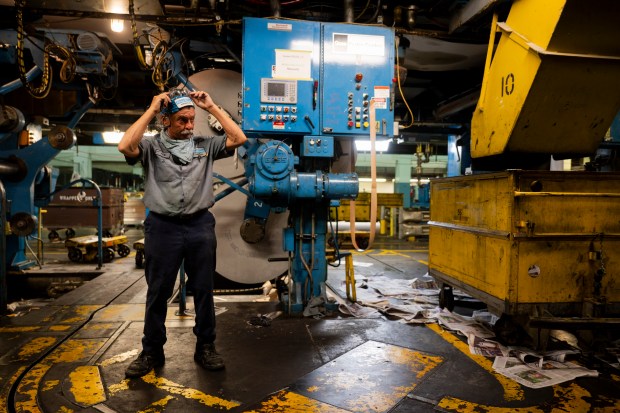
The 700,000-square-foot plant featured 10 new Goss Metroliner offset presses, each of which cost upward of $10 million and could print 75,000 144-page newspapers an hour. It was a huge step up from the cramped basement operation at Tribune Tower, which ceded all printing to Freedom Center in September 1982.
“The Freedom Center was a physical manifestation of the muscularity and influence of the Tribune at the time,” said Tim Franklin, senior associate dean at Northwestern’s Medill School of Journalism.
A former Tribune reporter and editor who started at the newspaper in 1982, Franklin remembered the pride that swept across the newsroom as the Freedom Center launched full production, a facility unrivaled in the industry.
Named in a contest by former Tribune reporter Casey Bukro, the Freedom Center became the whirring engine of Chicago journalism, where upward of a million newspapers would be printed and distributed each day, landing on driveways, doorways and retail shelves before dawn across a waking city.
While the state-of-the-art Freedom Center was a breath of fresh air compared with the dank subterranean printing operation at Tribune Tower, the tenure at the standalone River West plant was not without labor strife.
In 1985, 1,000 union production workers went on strike as their positions changed amid the new printing technology. Many never returned during the multiyear walkout after the Tribune hired replacements for the striking workers.
At the dawn of the new millennium, Chicago Tribune weekday print circulation averaged about 600,000 and topped 1 million on Sunday. Geographically zoned editions made the voluminous runs even more complex, keeping all 10 presses and scores of operators busy 24/7.
In 2002, Freedom Center expanded to 940,000 square feet, even as digital competition began to grow, increasing capacity for the still robust Tribune circulation, and enabling the plant to continue to build its commercial business.
Even the rival Chicago Sun-Times decided to stop its own presses in 2011, shuttering its 12-year-old printing plant on South Ashland Avenue and outsourcing the work to Tribune’s Freedom Center.
But in recent years, the rise of digital media precipitated a rapid erosion in print circulation, slowing production at Freedom Center and permanently retiring four of its 10 aging presses as demand for daily newspapers waned.
By 2023, Tribune print circulation had fallen to 73,000 on weekdays and 172,000 on Sunday, a 75% decline over the past decade, according to the latest data from the Alliance for Audited Media.
Excess capacity made the Freedom Center expendable for Tribune Publishing, which also lost its lease on an increasingly valuable piece of real estate under a succession of owners.
Tribune Media, the former broadcast parent of Tribune Publishing, kept all the real estate — including Tribune Tower and Freedom Center — when the newspaper company spun off on its own in 2014. Nexstar Media Group acquired Freedom Center as part of its $4.1 billion purchase of Tribune Media in 2019. Bally’s became Tribune Publishing’s landlord in November 2022 when it bought the Freedom Center site from Nexstar Media for $200 million.
Last year, Bally’s agreed to pay Tribune Publishing $150 million to vacate the Freedom Center by July 5 to break ground on the casino complex, which is slated to open in September 2026.
In recent years, newspapers across the country have closed, consolidated and outsourced production amid dramatically declining print circulation. The Los Angeles Times, a former sister paper to the Chicago Tribune, shuttered its sprawling 34-year-old downtown printing plant in March, farming out the work to the Southern California News Group in Riverside, nearly 60 miles away.
“There was this time when Freedom Center was part of a trend of building these off-site, ginormous standalone printing and distribution facilities,” Franklin said. “But most of those facilities have now been shut down around the country. And it’s much more efficient and much less expensive to produce news on pixels than it is on paper.”
The Freedom Center will wrap up all production June 2 with the final editions of The Wall Street Journal and New York Times.
But Tribune is staying in the newspaper printing business, trading the Freedom Center for the 21-year-old Daily Herald plant on 21 acres by the Elgin-O’Hare Expressway. The Schaumburg plant has two German-made Manroland presses, which have been resized to match the current Tribune print format.
A handful of press operators have already moved over to the Schaumburg plant, which has been printing the Life & Travel, Arts & Entertainment, Comics and Real Estate sections in the Sunday Chicago Tribune for several weeks.
Most of the Tribune’s commercial clients will also migrate to Schaumburg including The New York Times, Wall Street Journal and the Chicago Sun-Times, with the Daily Herald added to the roster as part of the plant purchase.
Commercial printing remains a profit center for the company, Ridder said.
“The commercial print and delivery business has been a solid business for Chicago Tribune for a long time, and I expect it to continue to be,” Ridder said.
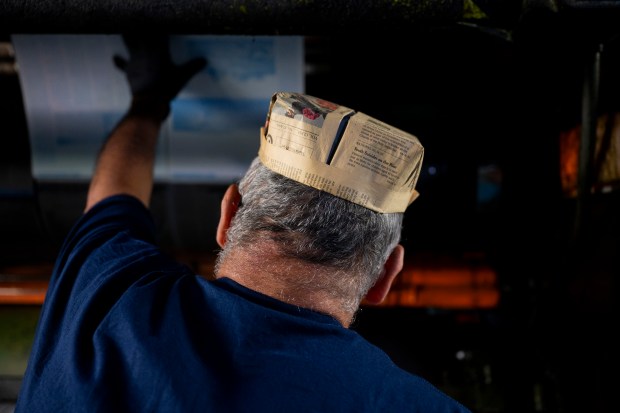
A significant number of Freedom Center production employees, however, will not be going to Schaumburg.
While Tribune declined to say how many production employees remain at Freedom Center, the company laid off nearly 200 packaging workers in April, outsourcing weekly advertising inserts to a facility in Milwaukee ahead of the move to the smaller Schaumburg site.
For many long-tenured press operators, who toiled for decades in the windowless bowels of the factory to print the daily first draft of history, it is also the end of the production line.
Of the roughly 40 press operators working this spring at Freedom Center, about a dozen have committed to move to Schaumburg, according to Terry Ford, 64, of River Grove, a 41-year plant veteran who serves as crew supervisor.
Ford is among those retiring in June — nearly three years earlier than planned — mostly to avoid the commute to the northwest suburbs.
“You’ve got to understand,” said Ford. “You’ve got tolls going out there now, the raises haven’t been forthcoming and you’ve got an aging workforce.”
Rick Ramirez, 61, of Hammond, a journeyman press operator who just completed his 25th year at Freedom Center, said it will be his last year as a Tribune employee after opting out of the move to Schaumburg.
Instead, Ramirez, who works the overnight shift, is planning a cross-country Route 66 road trip with his wife and then will try to find another path in an unexpected late-career detour.
“I actually thought this was going to be my last job ever,” said Ramirez. “But unfortunately, I’m going to have to start another chapter in my life.”
As printing operations shift to Schaumburg, the Chicago Tribune is also closing its Freedom Center newsroom May 31. The company has leased 3,700 square feet in the historic Brooks Building at 223 W. Jackson Blvd. in the Loop, with plans to move editorial operations there by July 1, according to Ridder.
Booted from its namesake tower in 2018, this will be the fourth location in six years for the peripatetic Tribune newsroom.
On Wednesday and Thursday, Tribune will hold an online auction for everything from printing equipment, dump trucks and forklifts to historical newspapers and press plates in a Freedom Center final liquidation.
The 10 printing presses, once the beating heart of Freedom Center, will essentially be sold for parts and scrapped, Ridder said.
“There just isn’t a market for that stuff,” Ridder said.
Freedom Center will give way to an entertainment complex including an exhibition hall, hotel, theater, restaurants and perhaps fittingly, a massive windowless casino building with 4,000 gaming positions at the center.
While the printing center will soon be relegated to the history books, a very small version of the Freedom Center will live on.
Horace Nowell, 27, who used to bike to Freedom Center as a child to watch freight trains deliver huge rolls of paper to the plant, spent five years building a scale model layout of the industrial site.
The painstakingly realistic model includes everything from the detailed plant emblazoned with the Chicago Tribune logo to authentic graffiti-laden boxcars navigating the grounds.
Completed as a 21-year-old Loyola University student in 2018, the model was on display in the printing plant’s lobby for 18 months. Nowell now keeps it in his Lakeview apartment.
“It was definitely a full circle moment to have it on display in the actual building,” Nowell said.
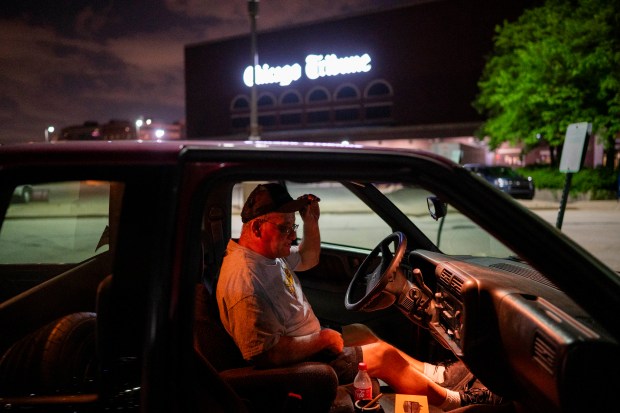
With the Freedom Center about to fall to the wrecking ball, Nowell would like to see his model back on display at a museum, or perhaps inside the successor casino.
Meanwhile, at the Freedom Center finale, a gaggle of Tribune reporters and editors crashed the proceedings Saturday night bearing congratulatory signs to bid the press operators farewell, and to thank them for putting their words on paper every day on deadline.
Former Chicago Tribune columnist Mary Schmich, a Pulitzer Prize winner whose latest story graced the front page of the final Tribune printed at the Freedom Center, felt moved to be among them.
“It’s historic to me, the idea that this huge building that represented so much about Chicago and about newspapering, is about to vanish,” said Schmich, one of 40 journalists to accept a buyout three years ago upon hedge fund Alden Global Capital’s acquisition of Tribune Publishing.
For the print operators themselves, it was an emotional night at work, at times celebratory, at times teary-eyed.
Cris Afante, 65, who started at the Freedom Center in 1985, was press crew supervisor on the final run of the Chicago Tribune at the plant. He will be heading to Schaumburg on June 2, but most of his crew will not be there.
“It’s just sad, because for a lot of these people, this is their other family,” said Afante. “We grew old together here. You can’t help but get attached to these guys after all those years.”
rchannick@chicagotribune.com


